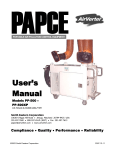Download Fender Power Stage 100 Computer Monitor User Manual
Transcript
POWERED MONITORS From Fender Pro Audio Owner's Manual for Power Stage 100 P/N 049810 REV B Fender Musical Instruments 7975 North Hayden Road, Scottsdale, Arizona 85258 U.S.A. Fender knows the importance of sound reinforcement. From the simple box-top mixer to today's professional touring concert systems, the need to communicate, to make the connection between the performer and the audience is foremost in Fender's mind. Perhaps no other single piece of gear can make or break your band's sound. You see, your sound system is more than just a combination of dials, wires and speakers. It is an integral part of the audio chain and should be treated with special care and attention to detail. At Fender, we know what building quality musical instruments and sound reinforcement equipment is all about. In fact, many of the world's best sounding electric musical instruments and sound reinforcement equipment proudly wear the Fender name. Whether you need a simple box top powered mixer for your Saturday afternoon jam, or a professional full-size concert system, Fender has the sound reinforcement equipment to meet your needs. Likewise, your decision to purchase Fender pro audio gear is one you will appreciate with each performance for years to come. Wishing you years of enjoyment and a heartfelt thank you, Bill Schultz Chairman Fender Musical Instruments Corporation POWERSTAGE 100 PROFESSIONAL POWERED MONITOR SYSTEM INTRODUCTION The PowerStage 100: a 100 watt powered monitor and general purpose compact sound system from your friends at Fender® Pro Audio. We are sure you will find the PowerStage 100 to be both a unique and effective sound reinforcement product, providing years of trouble-free service. Detachable Wired Remote Control Panel Variable Corner Low Pass Frequency Filter and Two Variable Center Frequency Notch Filters Enclosed in a quasi-trapezoidal floor monitor style cabinet, the PowerStage 100 includes a 3 channel preamp, a power amp, a power supply and a fullrange coaxial speaker system. With three angles of orientation, inputs for microphones and a variety of musical instruments, the PowerStage 100 is suitable for nearly every monitoring application. The PowerStage 100 also features a unique detachable wired remote control panel. All volume levels and frequency shaping can be controlled via the remote panel allowing for adjustments from the "performance position". 1/4 inch Stereo Headphone Jack Bass/Treble Boost with Bypass Switch Phantom Power Both 1/4 inch Phone TRS and 3-Pin XLR Female Input Connectors Insert Patch Point for Signal Processing Devices The versatile input panel and detachable remote control unit combined with the 100 watt power amplifier makes the PowerStage 100 the perfect general purpose compact sound system. With phantom power, 1/4 inch phone TRS and 3-Pin XLR female input connectors and a stereo RCA input connection, the PowerStage 100 can accommodate almost any input signal. By connecting a multieffects unit through the insert jack and adding the optional PowerStage Xpander 100, you now have a PA system ready for any small club or intimate setting. 1/4 inch Phone Output Jack for the Optional PowerStage Xpander Coaxial Speaker System Tough Metal Grille Carpet Covered Cabinet with Three Angles of Orientation 45º, 25º and 0º WARNING: - TO REDUCE THE RISK OF FIRE OR SHOCK HAZARD, DO NOT EXPOSE THIS UNIT TO RAIN OR MOISTURE. - NO USER SERVICEABLE PARTS INSIDE, REFER SERVICING TO QUALIFIED PERSONAL ONLY. - THIS UNIT MUST BE EARTH GROUNDED. 3 CONTROL PANEL FUNCTIONS Designed for maximum flexibility, the wired remote control section is the "brain" of the PowerStage 100. Whether hand held or mounted to a mic stand, the wired remote control unit governs all volume levels, frequency shaping and features a 1/4 inch headphone jack for personal monitoring. Constructed from rugged 18 gauge electrogalvanized steel and secured in place via ball stud and Tinnerman clips, the remote unit handles the most demanding, day to day setup and performance situations. A B C D E. LOW CUT - Designed to attenuate low frequency noise or "stage rumble", the LOW CUT knob is a variable corner (shelving) frequency control. By slowly rotating the knob, any undesirable low frequency noise, such as rumbling of a rocking microphone stand, can be diminished. F. LOW NOTCH Designed to a t t e n u a t e feedback or o t h e r E bothersome hums, the LOW NOTCH control is a G constant Q, F variable center frequency filter. The control attenuates frequencies between 200Hz and 2kHz. By slowly rotating the knob to locate the feedback frequency, it can be diminished. A. MIC 1 - The Mic 1 volume control. Rotating the knob clockwise increases volume. Because the Mic 1 input and the Mic 1 output connections are "daisy chained", adjusting the volume control will not affect the Mic 1 output signal to the main mixing console. B. MIC 2 / INST - The Mic 2 / Inst volume control. Rotating the knob clockwise increases volume. Any adjustments to this control will affect both the Mic 2 and the Inst output volume. G. HIGH NOTCH - Designed to attenuate feedback or other bothersome hums, the HIGH NOTCH control is a constant Q, variable center frequency filter. The control attenuates frequencies between 600Hz and 6kHz. By slowly rotating the knob to locate the feedback frequency, it can be diminished. H. LEVEL - Adjusts the volume level of the headphone output. Caution: Prolonged listening at high volume levels may be hazardous to your hearing and could possibly cause hearing damage. C. LINE - The Aux Line / Stereo Line volume control. Rotating the knob clockwise increases volume. Any adjustments to this control will affect both the Aux Line and the Stereo Line volume. D. MASTER LEVEL - Adjusts the overall volume level of the PowerStage 100. Again, rotating the knob clockwise increases volume. If the optional PowerStage Xpander 100 is connected to the system, the master level also controls the output volume for the other unit. H J I I. - A 1/4 inch stereo output jack for use with headphones. J. ENHANCE - Pressing this button in provides an increase in the bass and treble response of the PowerStage 100. 4 INPUT PANEL FUNCTIONS A. PHANTOM - When this button is pressed, a +15 V D.C. Phantom Power supply is activated, necessary for some condenser style microphones. Before plugging or unplugging any microphone, make sure the Phantom Power supply is off. B. MIC 1 IN - Plug your microphone in here. This three pin XLR balanced female input connector is intended for input signals from low impedance microphones. C. MIC 2 IN - An additional balanced microphone input for the PowerStage 100. Both the MIC 2 IN and the INST jack can be used simultaneously, however, any adjustments to the M IC 2 / I NST control knob will affect the volume of both the Mic 2 and Instrument inputs. D. AUX. LINE - A 1/4 inch TRS balanced input jack suited for use with items having a line level output. Both the AUX LINE and the STEREO jack can be used LINE simultaneously but remember, any adjustments to the AUX LINE / STEREO LINE control knob will affect the volume of both the AUX LINE / STEREO LINE inputs. F. PHANTOM POWER LED - This LED illuminates when the phantom power supply is on. A F B G H G. POWER LED - This LED illuminates when the PowerStage 100 is on. H. MIC 1 OUT - This three pin XLR balanced male output connector is used to send the MIC 1 input signal unmodified out to a mixing console. C I D J E K I. INST - A 1/4 inch TS unbalanced input jack suited for use with instrument level signals such as an acoustic guitar, a keyboard or a drum machine. Remember, any adjustments to the M IC 2 / I NST control knob will affect the volume of both the Mic 2 and Instrument inputs. J. STEREO LINE - These are unbalanced phono (RCA) input jacks designed for use with a stereo tape player, CD player, etc. These jacks produce a mono signal out and are useful for playing prerecorded music. Adjustments to the AUX LINE / STEREO LINE control knob will affect the volume of both the AUX LINE / STEREO LINE inputs. K. LINE OUTPUT - A 1/4 inch TRS unbalanced output jack designed to feed the optional PowerStage Xpander 100. E. INSERT - A 1/4 inch unbalanced TRS input / output phone jack designed for use with signal processing devices, such as a digital delay or a reverb unit. A special "Y" line cord (stereo to 2 mono) is required to use this jack. On the PowerStage 100, the tip is the send and the ring is the return. POWER SECTION L L. SUPPLY CORD JACK - The supply cord connects here. This is a grounding type supply cord to reduce the possibility of shock hazard. Be sure to connect it to a grounded receptacle. DO NOT ALTER THE AC PLUG. M 5 M.POWER SWITCH - Turns the AC power ON and OFF. When the switch is in the OFF position, the PowerStage 100 is completely shut down. WIRING AND CONNECTIONS SETTING UP THE POWERSTAGE 100 The PowerStage 100 utilizes a variety of connectors on its input panel. Below is a chart listing the various types of connectors on the PowerStage 100. Before using the PowerStage 100, please read and follow the steps listed below: Pin Out 1. Heed all safety warnings when operating the PowerStage 100. Balanced Input Pin 1 = GND Pin 2 = POS Pin 3 = NEG 2. Make sure the power switch is in the OFF position and all volume levels are in the Min position. XLR Male Balanced Output Pin 1 = GND Pin 2 = POS Pin 3 = NEG MIC 2 IN XLR Female Balanced Input Pin 1 = GND Pin 2 = POS Pin 3 = NEG INST 1/4" TS Unbalanced Input Jack Style Connection MIC 1 IN XLR Female MIC 1 OUT Balanced Input 3. Plug the female end of the supply cord into the Supply Cord Jack (item L page 5) of the PowerStage 100. Next, plug the supply cord into a power source with the correct voltage. 4. Connect the cord(s) from your microphone or other signal source(s) to the PowerStage 100's input jack(s). Tip = Input Signal Sleeve = GND AUX LINE 1/4" TRS Tip = POS Signal Ring = NEG Signal Sleeve = GND STEREO LINE INSERT Dual RCA 1/4" TRS Unbalanced Inner Ring = Signal Outer Shell = GND Input Unbalanced Tip = Send (output) Input/Output Ring = Return (input) Sleeve = GND LINE OUTPUT 1/4" TRS Unbalanced Output 5. If you have a PowerStage Xpander 100, connect it to the PowerStage 100 via the 1/4" Line Output Jack (item K). 6. First, turn all outboard gear, instruments and other equipment ON, then the PowerStage 100. 7. Adjust volume levels to the appropriate levels, listening for feedback or other ringing. Tip = Signal Output Ring = Terminated 100Ω to GND Sleeve = GND 8. If feedback is encountered, rotate the appropriate ( LOW or HIGH band) frequency notch filter control down to its lowest position. Next, slowly turn the frequency control knob to pinpoint the location of the problem frequency and cancel it. 9. Steps 7 and 8 may need to be performed more than once if several feedback problems occur. For more detail on setting up your PowerStage 100, please refer to the diagrams on pages 8 thru 11. 6 GROUNDING AND HUMS TROUBLESHOOTING Ground loops are probably the most common cause of hum and buzz in sound reinforcement systems and other audio products. A ground loop usually occurs if the separate pieces of equipment are plugged into different AC circuits. Also, if the audio wiring is placed too close to the power cords, hums or buzzes can bleed into the system. Still, improperly maintained power and audio cables are yet another cause of bothersome noise. In order to help minimize stray hums and buzzes, here are some helpful hints. If the PowerStage 100 is set up but does not function, please check the following items: • Is the PowerStage 100's power cord properly plugged into an electrical outlet? • Is the power cord properly plugged into the Power Stage 100's Supply Cord Jack? • Is there power at the outlet? • Does your instrument have power? • Are the volume control knobs on the Power Stage turned above the Min position? • Are the volume control knobs on your instruments turned above their minimum position? • Is the mic/instrument properly plugged into the Power Stage 100? • Is the mic/instrument turned on? • Are your audio cables frayed, cut or damaged? • If using a condenser mic, is the phantom power turned on? • If using an effects processor, is the "Y" line cord properly connected? 1. Keep all electronics connected to the sound system on the same electrical circuit. 2. Keep audio signals cables away from the AC power cords. 3. Use balanced cables when applicable. 4. Always plug the PowerStage 100 into a grounded AC electrical outlet. 5. Be sure to use properly maintained cords and cables with the PowerStage 100. CARPET COVERING CARE If after checking all of the above the PowerStage 100 is still not performing correctly, consult your authorized Fender Service Center. The PowerStage 100 is covered in a tough, soil resistant synthetic indoor/outdoor carpet for long life and lasting good looks. To clean the carpeted cabinet, use a brush to wipe away any smudges or dirt. For stubborn stains, a sponge with a light soapy solution may be used. Avoid spilling liquids on the operating surface, heat sink, grille, volume and tone controls, switches and speakers. ALWAYS unplug the PowerStage 100 before cleaning it and wait until it has dried before plugging in the PowerStage 100. 7 SIMPLE MONITOR SET UP 1. Connect your microphone to the Mic 1 IN. 2. Next, connect a cord from the Mic 1 out jack to your main mixing console. This is a mic level signal. 3. Your PowerStage 100 monitor is a dry signal. Any reverb or other signal processing heard through the main P.A. will NOT be heard in the PowerStage 100. 4. Remember, turning up the Mic 1 Volume will NOT affect the output of the main P.A. system. 8 FULL MIX MONITOR SET UP 1. Connect your microphone to the Mic 1 In. 2. Connect a cord from the Mic 1 Out jack to your main mixing console. This is a mic level signal. 3. Next, connect a cord from the monitor out on your mixing console back to the Aux Line In jack on the PowerStage 100. You now have a full monitor mix with all effects from your mixing console in the PowerStage 100. To turn up the full monitor mix, turn up the Line volume (item C page 4). 9 4. Remember, turning up the mic 1 volume will NOT affect the output of the main P.A. system, but it will affect how much of your "dry" signal you will hear. FULL MONITOR WITH AN INSTRUMENT 1. Connect your instrument to the Inst jack on the PowerStage 100 and to the line in on your mixer. 2. Connect a cord from the Instrument’s line output jack to your main mixing console. 3. Next, connect a cord from the monitor out on your mixing console back to the Aux Line in jack on the PowerStage 100. You now have a full monitor mix with all effects from your mixing console in the PowerStage 100. To turn up the full monitor mix, turn up the Line volume (item C page 4). 10 4. Remember, turning up the Mic 2 / Inst volume WILL NOT affect the output of the main P.A. system. It WILL determine how much of your "dry" signal you will hear. MINI PA SET UP (A ONE PERSON BAND) 1. Connect your microphone to the Mic 1 In jack, your instrument to the Inst jack and a tape or CD player to the Stereo Line jack. 2. Connect a cord from the line output jack to a PowerStage Xpander 100 (optional). 3. Next, an effects unit may be used by connecting a "Y" line cord to the insert jack (item E page 5). 4. Headphones out (item I page 4) on the detachable remote unit may be used for monitoring purposes. 11 SPECIFICATIONS DESIGNATION TYPE PR 306 PART NUMBER 071-0100-000 071-0100-030 071-0100-040 071-0100-060 POWER SPECIFICATION 120 V version: 120 VAC, 60 Hz 360 W 230 V version: 230 VAC, 50 Hz 360 W 240 V version: 240 VAC, 50 Hz 360 W PREAMP Ch. 1 (120 V) (240 V) Aust (230 V) UK (230 V) Euro THIS EQUIPMENT CONFORMS TO THE FOLLOWING DIRECTIVES : EMC 89/336/EEC AND LV 73/23/EEC System Gain Preamp Gain Input Level Nominal Minimum Maximum Input Impedance Phantom Voltage Mic 1 Mic 1 Mic 1 Mic 1 Mic 1 Mic 1 Mic 1 0 dB to +90 dB 0 dB to +60 dB -28 dBV -60 dBV 0 dBV 2 kΩ +15 V Ch. 2 System Gain Preamp Gain Input Level Nominal Minimum Maximum Input Impedance Phantom Voltage Mic 2 Mic 2 Mic 2 Mic 2 Mic 2 Mic 2 Mic 2 0 dB to +90 dB 0 dB to +60 dB -28 dBV -60 dBV 0 dBV 2 kΩ +15 V Inst Inst Inst Inst Inst Inst Ch. 3 System Gain Preamp Gain Input Level Nominal Minimum Maximum Input Impedance Aux Line Aux Line Aux Line Aux Line Aux Line Aux Line 0 dB to +60 dB 0 dB to +28 dB -21 dBV -28 dBV +20 dBV 20 kΩ Stereo line Stereo line Stereo line Stereo line Stereo line Stereo line LOW CUT FILTER Corner Frequency Slope -3 dB @ 30 Hz to 270 Hz -12 dB / Octave LOW NOTCH FILTER Center Frequency Depth Q 200 Hz to 2 kHz -20 dB 5 HIGH NOTCH Center Frequency FILTER Depth Q 600 Hz to 6 kHz -20 dB 5 ENHANCE +9 dB @ 100 Hz +5 dB @ 4 kHz Low Boost High Boost 0 dB to +75 dB 0 dB to +47 dB -24 dBV -47 dBV +13 dBV 220 kΩ 0 dB to +70 dB/side 0 dB to +33 dB/side -26 dBV/side -33 dBV/side +5 dBV/side 25 kΩ/side HEADPHONES Maximum Output 14 mW into 8 Ω, 1% THD + Noise 165 mW into 300 Ω, 1% THD + Noise POWER AMP Nominal Power Maximum Power Frequency Response THD + Noise Output Impedance Input Sensitivity 100 W into 8 Ω, <0.05% THD+Noise @ 1kHz 108 W into 8 Ω, <0.1% THD+Noise @ 1 kHz +0 dB, -3 dB 20 Hz to 40 kHz @ Nominal Power <0.05% @ 1 kHz, 100 W into 8 Ω 0.2 Ω @ 1 kHz, 0.02 Ω @ 100 Hz 1 V RMS, 0 dBV DIMENSIONS (At 25º) Height: Width: Depth: Weight: 18 in 23.5 in 12 in 45 lbs 45.7 cm 59.7 cm 30.5 cm 20.4 kg A PRODUCT OF: FENDER MUSICAL INSTRUMENTS CORP. CORONA, CA 91720 USA Product specifications are subject to change without notice.





















